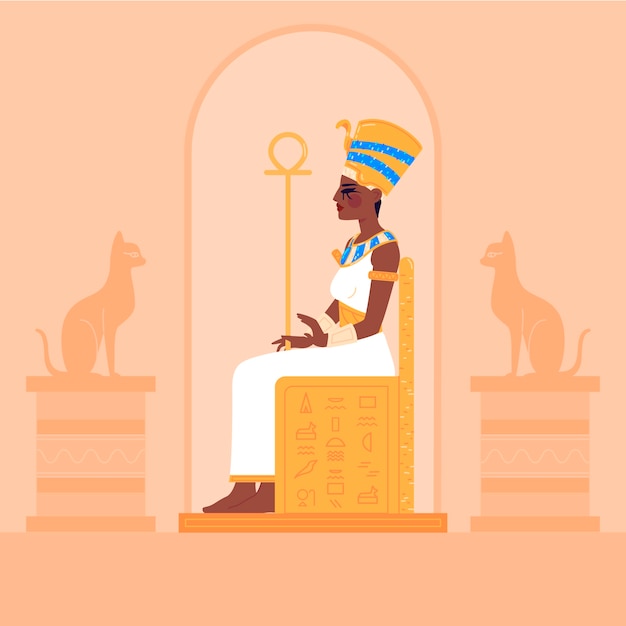Fascinating Trivia about King Tut

King Tutankhamun of ancient Egypt ascended to the throne at the young age of 9 or
2. The discovery of King Tut’s tomb in 1922 by Howard Carter and Lord Carnarvon remains one of the most significant archaeological finds in history.
King Tut is often referred to as the Boy King due to his young age at the time of his reign.
Despite his short reign, King Tut is one of the most famous pharaohs of Egypt.
King Tut’s tomb contained an extensive collection of grave goods, including furniture, jewelry, and even chariots.
The famous golden burial mask of King Tut is considered one of the most iconic symbols of ancient Egypt.
King Tut’s tomb was decorated with intricate wall paintings depicting scenes from his life and the afterlife.
The cause of King Tut’s death has been a subject of debate among historians and scientists, with theories ranging from illness to murder.
King Tut’s father was the pharaoh Akhenaten, known for his religious revolution and the introduction of monotheism.
Despite the wealth found in King Tut’s tomb, he was not considered a particularly powerful or influential pharaoh during his lifetime.
King Tut’s tomb was found in the Valley of the Kings, an ancient burial ground for pharaohs on the west bank of the Nile.
The discovery of King Tut’s tomb sparked a worldwide fascination with ancient Egypt and Egyptian artifacts.
King Tut’s mummy has been subjected to extensive scientific analysis, including CT scans and DNA testing.
Fascinating Trivia about King Tut part 2
King Tut’s tomb contained four gilded shrines nested within each other, each housing different artifacts and treasures.
Due to his young age, King Tut likely had several regents and advisers who made decisions on his behalf.
King Tut’s burial chamber contained four golden canopic jars, each holding the organs that were removed during the mummification process.
The artwork found in King Tut’s tomb provides valuable insight into the religious and cultural beliefs of ancient Egypt.
King Tut’s tomb was the only one found intact in the Valley of the Kings, which had been raided by tomb robbers for centuries.
The discovery of King Tut’s tomb fueled a renewed interest in ancient Egyptian art and design, influencing various art movements in the 1920s.
One of the most mysterious aspects of King Tut’s tomb is the presence of a curse associated with those who entered the burial chamber.
King Tut’s tomb contained over 5,000 artifacts, making it one of the richest archaeological discoveries ever.
The burial chamber in King Tut’s tomb contained a golden shrine, believed to be a representation of the mythical Bed of Osiris.
The death mask of King Tut is made of solid gold and weighs around 24 pounds.
King Tut’s tomb contained several sets of funerary furniture, including thrones, chairs, and beds.
Some scientists believe that King Tut may have suffered from a genetic disorder called Köhler disease, which affected his foot.
King Tut’s tomb was sealed with clay and guarded by an intricate system of doors and seals.
The innermost shrine in King Tut’s tomb housed a sarcophagus made of solid gold, within which the pharaoh’s mummy was placed.
King Tut’s tomb contained a wide assortment of weapons, including bows, arrows, and daggers.
The walls of King Tut’s tomb were covered in religious texts, spells, and prayers, designed to assist the pharaoh in the afterlife.
King Tut’s tomb contained various musical instruments, including harps, trumpets, and drums.
The discovery of King Tut’s tomb inspired numerous books, movies, and works of art, further immortalizing the young pharaoh.
King Tut’s burial mask was found directly on top of his mummy, ensuring his eternal protection and divine identity.
The artifacts found in King Tut’s tomb have provided valuable insights into the advanced craftsmanship and artistic skills of ancient Egyptians.
King Tut was buried with four miniature boats, symbolizing his journey through the afterlife.
King Tut’s tomb contained various foods, beverages, and perfumes, meant to sustain him in the afterlife.
The discovery of King Tut’s tomb shed light on the reign of pharaohs during the 18th dynasty of ancient Egypt.
King Tut’s tomb contained statues of various deities and guardian spirits, to protect him in the afterlife.
The walls of King Tut’s tomb depicted scenes from the Egyptian Book of the Dead, a collection of spells and rituals to guide the deceased in the afterlife.
King Tut’s tomb was resealed after its initial opening to preserve the contents and protect them from damage or theft.
King Tut’s burial mask is adorned with precious stones, including lapis lazuli and obsidian.
The treasures found in King Tut’s tomb were meticulously cataloged and studied, providing valuable information to modern Egyptologists.
King Tut’s tomb contained a gilded shrine called a naos, which housed a smaller replica of the pharaoh’s tomb.
The construction of King Tut’s tomb took around 70 days, which is relatively short compared to other royal tombs of ancient Egypt.
The walls of King Tut’s burial chamber were inscribed with spells and incantations to protect and guide the pharaoh’s soul in the afterlife.
The discovery and excavation of King Tut’s tomb marked a turning point in the field of archaeology, revolutionizing techniques for preserving and studying ancient artifacts.

